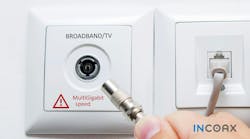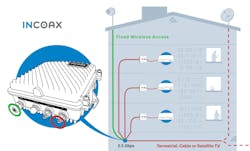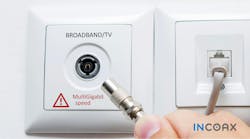Solving the MDU Puzzle
Curing the connectivity headache for MDU tenants with fiber and FWA extension tech.
Fiber rollouts have been prevalent over the last half decade or so, as major incumbents and alternative network providers seize the opportunity to deliver this reliable technology to their growingly expectant customer bases. Of course, these fiber-to-the-home (FTTH) strategies will undoubtedly encounter challenges along the way. This includes the operational difficulties of deploying fiber or 5G fixed wireless access (FWA) in both rural and urban locations.
In rural settings, there are fewer people per mile, so costs are typically higher to connect fewer customers. Distance, cost, and labor shortage are all factors to consider in these environments. The terrain might also be more troublesome and this, combined with less existing infrastructure to utilize, is a precursor as to why network operators tend to target urban areas.
In 2022 alone, 343,000 multi-dwelling units (MDUs) were built across the United States and the number of existing brownfield MDUs still represents a significant market share.
But while it might be natural to assume that slow broadband is typically a trait only associated with rural areas, that is a mistaken belief. Dense urban environments hold their own challenges. Yes, they are likely to cover many customers in a small geographic radius, but rollout issues include street works access and increasing market competition. So, what are the options for network operators and fiber builders looking to stay competitive in a growingly competitive landscape?
Growing, Growing, Grown – the MDU Dilemma
Reusing existing in-building infrastructure is no new phenomenon. But its importance cannot be overstated. For residents looking to gain access to gigabit, or even multi-gigabit speeds and the flurry of applications and services available to them, harnessing the existing coaxial cabling can be a cost-effective complement to network operators’ overall FTTH strategies. But a key market that also has to be considered is how to connect hotels, apartments, and office blocks with this ubiquitous connectivity affordably and quickly.
In 2022 alone, 343,000 multi-dwelling units (MDUs) were built across the United States1 and the number of existing brownfield MDUs still represents a significant market share. Compared to signing a broadband contract with a single-family unit, MDUs typically involve building owners and tenants. If landlords wish to deliver fiber or 5G FWA connectivity to multiple occupants simultaneously, it can be a costly process, and the potential cosmetic damage and disruption is significant.
For a long time, service providers in MDUs have had to work out how they can deliver fiber and FWA quickly to a large number of residencies. Key considerations for them include wiring infrastructure changes and contract requirements such as the number of minimum take-up rates.
It is important to note, however, that these MDU buildings have existing coaxial cabling or telephone lines. This offers an alternative option to laying fiber direct to the premises or Ethernet cabling for each apartment for 5G FWA. Network operators and fiber builders have begun to give Fiber Access Extension technologies consideration, especially if some locations have a low take-up rate. The expense needed to install fiber is not necessarily counterbalanced by the number of new customers in certain environments.
Fiber Access Extension Tech – a Lucrative Option
Growing competition in the broadband market has fueled the need for fiber to be pushed deeper into the network. Fiber deployment strategies can be executed all the way to the subscriber using cost-effective solutions to increase the number of subscribers they can address, as well as providing a faster return on investment.
When laying and installing fiber directly to the premises, it involves reusing copper phone lines and this may not deliver the consistent gigabit services that operators crave. But by reusing existing in-building infrastructure, such as coaxial cabling, for broadband access, it has become an attractive, uncomplicated proposition for service providers. Multi-gigabit data rates are not sacrificed, and Fiber Access Extension technology also minimizes infrastructure recabling costs.
Breaking Down FWA Barriers
One issue commonly faced when using 5G mmWave technology, is the difficulty sending mmWave signals through walls. Gigabit and multi-gigabit services require operators to use mmWave within the 24–100GHz spectrum to reach the service speed criteria. At these high frequencies signal strength can be attenuated as much as 45dB through each wall, resulting in the 5G mmWave indoor coverage being uncertain and, in many cases, not possible.
Most building materials, such as brick and concrete, and even windows to some extent, attenuate and reflect very high-frequency signals. With the coverage interference being significant, it is unlikely that users will receive a great signal moving from inside to outside. This problem is exasperated further due to the higher frequencies used for mmWave, the structure of MDUs with multiple walls, and interference with other signals.
If FWA modems are installed on the rooftop of an MDU, as it requires line of sight to the associated base stations, then Ethernet cabling must be laid to each apartment. But the two biggest barriers to this approach is expense and the time it takes to deploy.
Today, one FWA modem is required for each subscriber and is deployed on the rooftop. In a large MDU, this could require more than 100 modems to be deployed, which presents the challenge of finding adequate rooftop space, the required RF separation, and co-site interference issues. A significant barrier for many operators is securing the required agreements or permits to gain access to the inside of buildings.
5G mmWave FWA Extension – a Viable Solution for MDUs
A new project has been launched by Broadband Forum to solve this problem and help connect MDUs with 5G FWA that provides multi-gigabit connectivity speeds. Apartments can be reached by reusing the existing property infrastructure cabling already available, such as twisted pair or coaxial cabling, to extend FWA connectivity from the attic or basement of the building. This will achieve greater scalability, shortened deployment times, and OpEx and CapEx savings.
Network operators are investing heavily to acquire spectrum space and base station infrastructure to bring value-added services to their customers, and a fast return on investment can be delivered by turning DSL customers into 5G FWA subscribers. A 5G FWA modem can cater for multi-gigabit data rates when using mmWave technology, so multiple customers can share the same modem over the air link and the connection can be extended thanks to the existing infrastructure being utilized.
The New Tech Making This Happen
An increasing number of global network operators are now offering multi-gigabit services (two gigabit or more), with an Omdia report2 from 2022 reporting that 25 U.S. operators offer multi-gigabit speeds. Similarly, the Fiber Broadband Association predicted3 that data rates (both upstream and downstream) will grow to 2 Gbps inside the home by 2030.
Combing the in-building coax network with fiber access technology such as MoCA AccessTM helps simplify deployments for operators that target a higher market share in the multi-gigabit space. This is a type of modem that connects the customer premises equipment (CPE) to the operator’s network. MoCA Access 2.5 technology can deliver 2.5 Gbps symmetrical data rates over existing property infrastructure, be self-installed by the customer, and auto-configure at start-up. It offers a fast-to-install and cost-effective alternative to full-fiber solutions and can coexist with legacy TV services.
By utilizing existing property infrastructure, such as coax for both fiber and 5G FWA connectivity, network operators can continue to grow their market shares. But leveraging coaxial cable networks is the wise choice to deliver multi-gigabit data rates and a reliable, ubiquitous broadband performance now, and in the foreseeable future for the individual MDU tenant.
REFERENCES
1. Statista, statista.com/statistics/1011965/multifamily-housing-completions-usa/
2. Omdia, omdia.tech.informa.com/om024143/how-gigabit-became-the-broadband-standard
3. Fiber Broadband Association, fiberbroadband.org/2023/04/11/fiber-access-extension-technology-set-for-critical-role-as-the-race-for-multigigabit-speeds-intensifies/
About the Author
Helge Tiainen
Head of Product Management, Marketing & Sales, InCoax
Helge Tiainen is Head of Business Development, Marketing & Sales at InCoax Networks. As head of business development, marketing, and sales at InCoax, Helge is responsible for developing sales and marketing of existing products and new business opportunities among cable, telecom, and mobile operators by developing use cases and technologies within standards organizations as Broadband Forum, MoCA, Small Cell Forum, and other working groups. He also manages partnerships of key technology partners suited with InCoax initiatives. For more information, visit www.incoax.com. Follow them on LinkedIn and Twitter.



